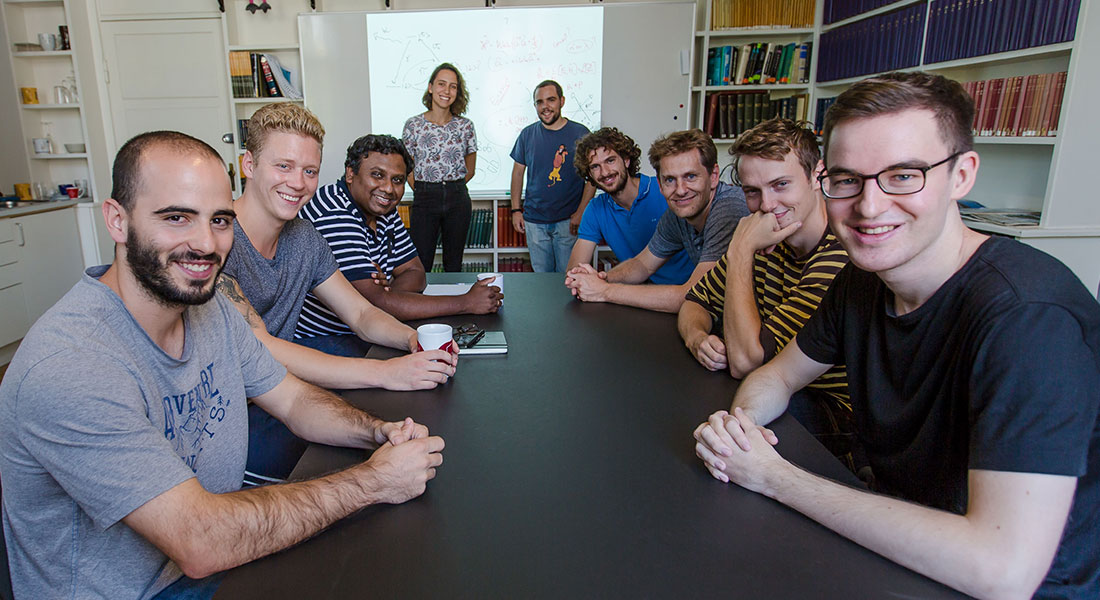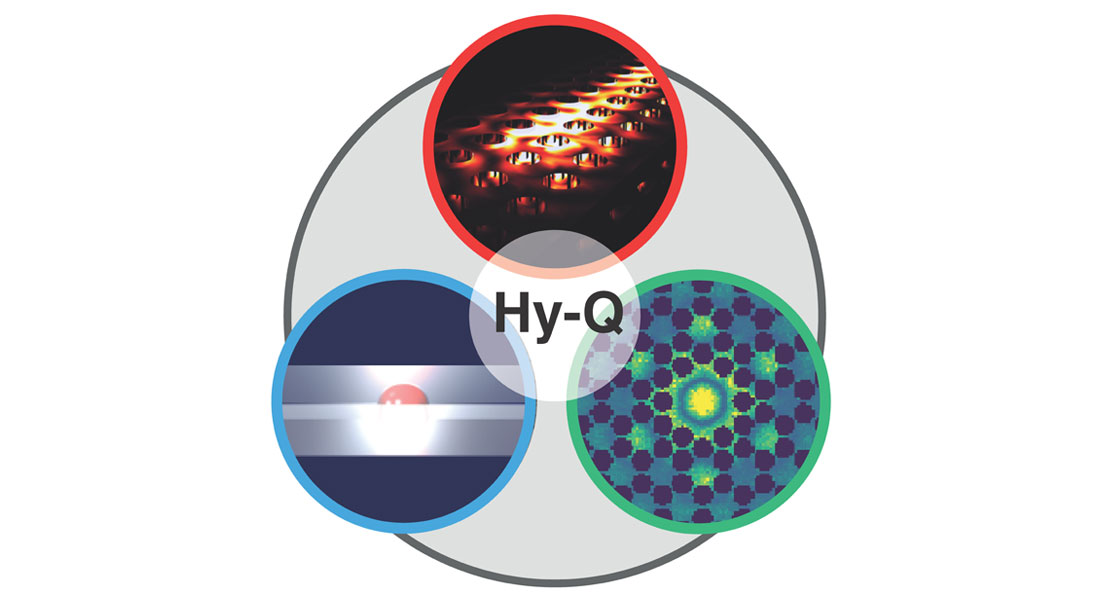
Quantum Optics and Photonics
The Quantum Optics section conducts experimental and theoretical research in Quantum Optics, in particular, in Quantum Information Processing, Quantum Sensors, and Quantum Technologies.
We use photons, from optics to microwaves interacting with a wide variety of quantum matter, such as quantum dots, single atoms, atomic ensembles and mechanical oscillators.
The overarching theme is generation and manipulation of non-classical entangled states for quantum simulation, sensing and communication. The research directions span from fundamental research to device engineering.
The section consists of four experimental groups and a theory group.
The permanent faculty members within the section are Professor Peter Lodahl, Associate professor Joerg H. Müller, Professor Eugene S. Polzik (head of the section), Professor Albert Schliesser, Professor Anders S. Sørensen, and Professor Jan W. Thomsen.
Students supervised by the section professors get involved in forefront research at all levels. We supervise approximately 15 bachelor students, 15 M.Sc. students and 20 Ph.D. students every year.
Professors of the section teach undergraduate and advanced courses, such as Optics, Quantum Mechanics, Atomic Physics, Experimental Physics, Optical Physics and Lasers, Quantum Optics, Quantum Information and Advanced Quantum Optics and Photonics.
The Niels Bohr institute has many M.Sc. and PhD students. The students are closely attached to the research groups and supervisor, and have many social activities for International and Danish students.
If you are interested in studying Quantum Optics, consider looking at these pages:
Quantop
Professor Eugene S. Polzik: We run experiments where quantum light is used to perform tasks in quantum sensing and quantum communication.

We use ensembles of hot and ultracold atomic spins to generate single photon, squeezed and entangled states of matter and radiation, and use them for measurement of magnetic and electromagnetic fields with unprecedented precision.
Application include bio- and medical sensing. Using photons and mechanical oscillators we aim at generation of non-classical states of motion of macroscopic objects to study the limits of quantum physics. We also combine mechanical and spin systems by quantum measurement with the goal to surpass standard quantum limits for measurement of motion.
Application of those methods towards enhanced sensitivity of gravitational wave detectors is investigated.
Quantum Metrology
Assoc. Professor, Jörg H. Müller: The Quantum Metrology group is an experimental atomic physics group focusing on research within frequency references and atomic clocks.

The group has experiments with cold alkaline-earth metals such as strontium and molecular spectroscopy. The group also works with frequency combs based on microresonators, and ultra-stable optical reference cavities. Most of our work is based on cavities and the enhanced interaction of matter and electromagnetic fields described by many-atom cavity QED systems.
Quantum Photonics
Professor Peter Lodahl: The Quantum Photonics Group investigates the fundamental quantum interaction between light and matter in a solid-state platform.

Our quest is to develop a deterministic photon-emitter interface based using quantum emitters and photonic nanostructures for real-world quantum technology applications within quantum communication, quantum simulations, and quantum computing. The group conducts fundamental and applied research and quantum engineering reaching all the way from fabrication and design of quantum photonics devices, through quantum optics experiments, to the theory of light-matter interaction and quantum-information protocols. The research has led to several quantum technology patents and spin-out companies.
Quantum Optomechanics
Professor Albert Schliesser: The Optomechanics group experiments with mechanical systems deeply in the quantum regime. We engineer mechanical resonators with extremely low dissipation, and probe them with optical and microwave photons.

In this setting we push the quantum limits for measuring motion, investigate decoherence mechanisms, and implement control and conversion schemes with mechanical quantum states. We translate our findings to application in quantum technologies, such as novel quantum sensors for electromagnetic fields and forces, imaging modalities, and mechanical interfaces that can store and translate quantum information in hybrid quantum networks.
Theoretical Quantum Optics
Professor Anders S. Sørensen: The Theoretical Quantum Optics group develops theories for how to control and exploit individual quantum systems, e.g. single atoms or photons.

Most of the research is focused on developing methods to implement quantum information processing in practice, especially quantum communication. The group investigates how to achieve this in several different physical systems, ranging from single atoms and photons to solid state systems. The group has a close collaboration with the experimental groups in the section.
Center for Hybrid Quantum Networks (Hy-Q)
The vision of the Center for Hybrid Quantum Networks (Hy-Q) funded by the Danish National Research Foundation is to exploit and implement novel approaches to interfacing different solid-state quantum photonic systems.

A hybrid route to quantum networks is pursued in a “best of all worlds” approach where the advantages of the different platforms are utilized. Key research areas include deterministic emitter-photon and spin-photon interfaces for single-photon and multi-photon sources, long-lived mechanical membranes for quantum memories, and solid-state spin physics.
The long-term perspective of the research is to enable large scale processing of quantum information over global distances, also known as The Quantum Internet.
Center for Biomedical Quantum Sensing (CBQS)
The Center for Biomedical Quantum Sensing is focused on biomedical applications, establishing a new paradigm of quantum-enabled medicine, and the vision is to bring advances in quantum technologies into medical diagnostics and healthcare.
The mission is to develop novel quantum-enabled sensing techniques for early detection and cure of disease, and for unraveling complex molecular interactions and cellular mechanism and to nurture the next generation of quantum-ready workforce for bio- and medical industries.
iqClock
The integrated quantum Clock project focuses on the next generation of atomic clocks based on continuous superradiant lasing in cold strontium atoms as well as the technological maturation of traditional optical atomic clocks.

The goal of the consortium is to implement a fully functional optical lattice clock with end-users and test it as timing reference in a telecommunications centre. While developing this prototype we are also preparing the first demonstration of continuous superradiance in an ensemble of ultra-cold atoms. An active atomic clock based on superradiant lasing promises higher performance at short times, and a significant reduction of some of the fundamental limitations in traditional passive clocks.
QIA
The Quantum Internet Alliance (QIA) (http://quantum-internet.team) is a joint European effort which is part of EU’s flagship initiative on quantum technologies. The long-term ambition is to build a Quantum Internet that enables quantum communication applications between any two points on Earth.

To achieve this ultimate goal, the team joins physicists, computer scientists and industrial partners in order to develop the necessary components of the quantum internet, from basic hardware to software stack and end user applications.
Dorte Christiane Garde Nielsen
Research Secretary
Niels Bohr Institute, Quantop
Blegdamsvej 17, 2100 København Ø
Phone: +45 35 33 01 80
Email: Dorte.Garde.nielsen@nbi.ku.dk
Charlotte Hviid, Administrative coordinator
Niels Bohr Institute
Blegdamsvej 17
2100 København Ø.
Office: Bygning T, Ta2a
Email: hviid@nbi.ku.dk
Phone: +45 35 32 52 54
Anders Søndberg Sørensen, Professor
Head of section
Blegdamsvej 17, 2100 København Ø.
Bygning F & T, Building: 12-0-TA1A
Email: anders.sorensen@nbi.ku.dk
Phone:+45 23 38 20 45
Mobil:+45 35 32 52 40
Staff
NBI Quantum News










